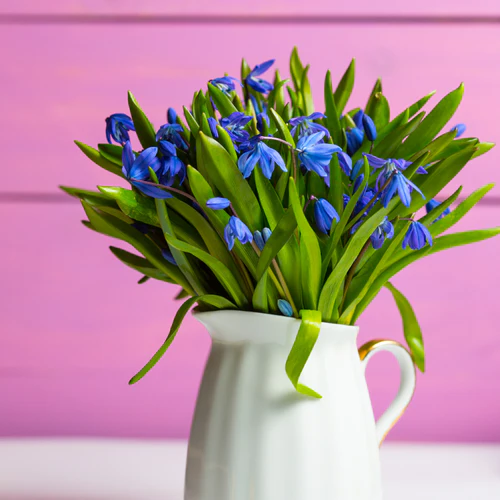Scilla 101
Welcome to the enchanting world of Scilla! Get ready to be captivated by the beauty of these delicate spring flowers. With their vibrant blue petals, Scilla siberica is sure to bring a burst of color and joy to any garden. These bulb plants are an absolute delight to behold, and you’re in for a treat as we explore their fascinating features further.
About Scilla

Also known as Siberian Squill. Scilla is a beautiful flowering plant that belongs to the Asparagaceae family. It is native to regions like Siberia and other parts of Europe. Scilla is known for its vibrant blue or purple flowers that bloom in early spring, adding a splash of color to gardens and landscapes. These delicate flowers are bell-shaped and grow in clusters on sturdy stems.
Naturalizing
Scilla has become a beloved choice among gardeners seeking low-maintenance plants. Its unique characteristic of spreading quickly allows it to create a captivating carpet of enchanting blooms in no time. For those looking to add beauty and charm to their gardens without the hassle, Scilla proves to be an exceptional choice for mass landscaping.
Symbolism
Scilla, with its breathtaking beauty, holds a deeper significance in various cultures. Beyond being a visual delight, this vibrant flower symbolizes rebirth and new beginnings. It blooms during the early spring season, marking the start of a fresh chapter in nature’s cycle. In many cultures, Scilla serves as a powerful reminder of the resilience and potential for growth that comes with embracing change. Its delicate petals carry messages of hope and optimism for those seeking to embark on new journeys or turn over a new leaf in their lives.
How to Grow Scilla

If you’re looking to add a burst of vibrant color to your garden, planting and propagating Scilla bulbs is a great choice. These hardy bulbs are known for their beautiful blue flowers and can thrive in various growing conditions. In this section, we will guide you through the process in 5 easy steps, ensuring successful growth and blooming.
Step 1: Soil Preparation
Preparing the soil is crucial for the healthy development of your Scilla bulbs. Choose a well-draining location with fertile soil. Fertilizing bulbs is another important aspect of their care routine. Before planting Scilla bulbs, incorporate well-balanced bulb fertilizer into the soil according to package instructions. This will provide essential nutrients for healthy growth and vibrant blooms. During the growing season, you can supplement with a slow-release fertilizer or liquid fertilizer specifically formulated for bulbs.
Step 2: Spacing
When it comes to planting Scilla bulbs, proper spacing is essential. Leave enough room between each bulb to allow for optimal growth and spread. Aim for a spacing of about 3-4 inches between each bulb, ensuring they have enough space to flourish without overcrowding.
Step 3: Depth of Planting
The depth at which you plant your Scilla bulbs plays a significant role in their overall health and blooming potential. Dig holes that are approximately 3-4 inches deep. Place the bulbs in the holes with their pointed ends facing upwards, gently covering them with soil.
Step 4: Watering Techniques
Once your Scilla bulbs are planted, it’s important to establish proper watering techniques. These plants prefer moist soil, so it’s crucial to water them regularly. However, be cautious not to overwater as it can lead to root rot. A good rule of thumb is to water deeply once a week, allowing the soil to dry slightly between waterings.
Step 5: Maintenance and Care
To ensure continued success with your Scilla bulbs, regular maintenance is necessary. Keep an eye out for any signs of pests or diseases and take appropriate measures if needed. In addition to regular watering, mulching can greatly benefit your Scilla plants. Applying a layer of organic mulch around the base of the plant helps retain moisture in the soil and suppresses weed growth. It also acts as insulation during extreme temperatures, protecting the bulbs from harsh weather conditions.
Common Problems with Scilla Plants

Maintaining a beautiful garden can sometimes be challenging, especially when it comes to dealing with pests and diseases that can harm our beloved plants. In the case of Scilla, these enchanting flowers are not exempt from facing their fair share of troubles. However, fear not! With the right knowledge and proper pest control methods, you can ensure the health and longevity of your Siberian squill garden.
When it comes to pests that commonly affect Scilla, there are a few culprits to watch out for. One such pest is the bulb mite, which feeds on the bulbs and can cause significant damage if left unchecked. Another common pest is the slug, known for its voracious appetite for tender plant leaves. Additionally, squirrels and mice may also pose a threat to your Scilla by digging up bulbs or nibbling on foliage.
Have Fun with Scilla

To enhance the beauty of these flowers even further, consider pairing them with companion plants that complement their colors and textures. For instance, daffodils or tulips can create a striking contrast when planted alongside Scilla. The combination of yellow or red blooms with the blue hues of the Scilla will create an eye-catching display that is sure to impress.
Additionally, you can experiment with different heights and layers by planting taller companion plants such as ornamental grasses or shrubs behind the low-growing Scilla. This will add depth and dimension to your garden design while providing a backdrop that allows the Scilla to truly shine.
So why not unleash your creativity and let these charming flowers inspire you? With their enchanting blue blossoms and countless companion plant possibilities, incorporating Scilla into your garden design is sure to bring joy and beauty for seasons to come.


